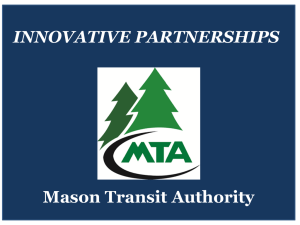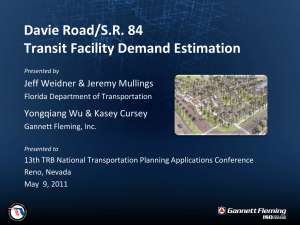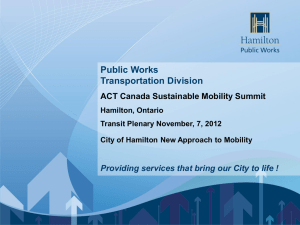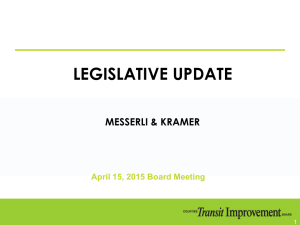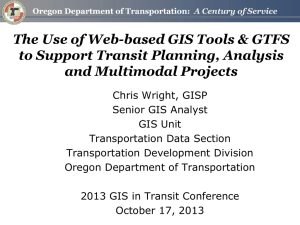wsf emme/2 model
advertisement
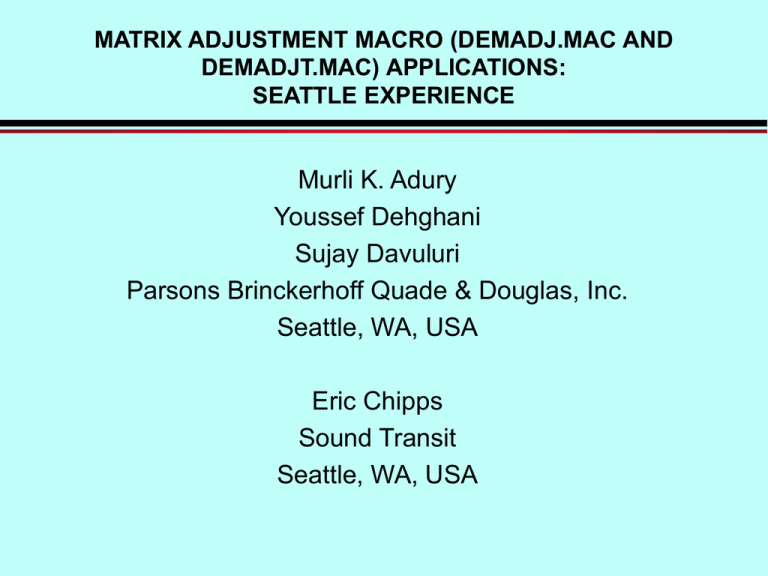
MATRIX ADJUSTMENT MACRO (DEMADJ.MAC AND DEMADJT.MAC) APPLICATIONS: SEATTLE EXPERIENCE Murli K. Adury Youssef Dehghani Sujay Davuluri Parsons Brinckerhoff Quade & Douglas, Inc. Seattle, WA, USA Eric Chipps Sound Transit Seattle, WA, USA Project(s) Context Microsimulation on Two Major Highway Corridors : » I-405 Corridor Alternatives Analysis – Highway Capacity Expansion Alternatives to Alleviate Congestion on I-405 » Alaskan Way Viaduct (AWV) Project – Project to Replace and Rebuild a highway vulnerable to earthquake – Microsimulation to Evaluate Traffic Impacts Due to Construction Project Area Map - I-405 Corridor Study - Alaskan Way Viaduct Project Microsimulation for I-405 & AWV - 1 - Purpose and Need I-405 Study » Be able to evaluate freeway capacity enhancement elements of the preferred alternative » Be able to refine and/or modify capacity enhancement elements of the preferred alternative » Be able to highlight potential deficiencies – e.g., lid concept thru downtown Bellevue AWV Project » Evaluate options for construction sequencing » Develop traffic control plans as part of overall mobility plan Microsimulation for I-405 & AWV- 2 INTEGRATION was selected as preferred microsimulation software program INTEGRATION model to interface with regional EMME/2 Travel Demand Model » Obtain base highway network – freeway and parallel arterials » Obtain PM peak hour O-D trip tables Microsimulation for I-405 & AWV – 3 Model Development Process Network preparation/calibration Data collection » Details of network geometry » Signal timings » Traffic counts Trip table development Model validation analysis Model application Microsimulation for I-405 & AWV– 4 Trip Table Development Regional model produced PM peak period vehicle trip tables for HOVs and Non-HOV » Apply factors to convert peak period trips to peak hour trips Post regional modeling procedure: » Directional peak-hour base year counts were seeded on designated links on I-405 and arterials » Matrix adjustment macro DEMADJ.MAC developed Heinz Spiess was used to update original matrix Microsimulation for I-405 & AWV– 5 Trip Table Development Continued Post regional modeling procedure: » Screenline Analysis performed on assignment from adjusted matrix » Utilized Traversal Matrix assignment feature of EMME/2 to extract sub-area O-D trip tables » Allocated and proportioned O-D trip table from EMME/2 model to correspond to detailed zone structure for microsimulation model Microsimulation for I-405 & AWV - 6 Model Validation Analysis Initial analysis indicated that study area networks needed to be streamlined: Prepared link-level comparisons: » Total flow, Travel time, Speeds » Queue length Comparative analysis of queue build-up against recurring bottleneck areas posted on the WSDOT real time traffic flow map Accomplished reasonable base year validation results Model successfully utilized for future year applications Model Validation Analysis - Continued - Lessons Learned Trips input into microsimulation from planning models need to be adjusted to counts Adjustment of “seed” trip table from a planning model is better than synthesizing O-D trips for microsimulation Useful features of EMME/2 » Can use Demand Adjustment Macro » Can use matrix manipulation techniques to extract sub-area matrices and to proportion trips to detailed zone structures Demand Adjustment for Transit Trips Analysis Motivation Sound Transit (ST) to build light rail (LRT) Requirement of agreement between Federal Transit Adminstration and ST is : » To maintain model databases representing conditions before and after the (LRT) project “Before” Conditions model circumstances: » No current transit onboard survey data being available » Link and route-level transit passenger counts by time of day being available Transit Components Map Sound Transit Model History Sound Transit (ST) EMME/2 model: » Initially developed in 1992 to produce more accurate route-level ridership forecasts » Incremental using comprehensive transit onboard survey data » Relies on the regional 4-step model for external factors such as change in demographics, congestion & travel costs » Updated recently to reflect 1999 transit service levels and transit travel patterns Matrix Adjustment Process -Initial Steps Updated transit network reflecting service levels for fall of 2002 – over 400 routes Performed transit network calibration analysis » Compared line times from EMME/2 model against scheduled (actual) line times » Detailed verification of line headways, operating hours and miles Matrix Adjustment Process - Continued Relied on the methodology developed by Heinz Spiess (DEMADJT.MAC) » Minimization of difference between estimated and observed link volumes on each route » Travel patterns in seed matrix not changing more than necessary Identified transit passenger counts locations Matrix Adjustment Process - Continued Extracted and processed appropriate data from the Automated Passenger Count (APC) GIS database » Counts by time period » Counts on over 200 links representing over 300 directional transit route at heavy load segments » Used complementary vicinity count locations to avoid under- or over-representation » Achieved convergence after 10 iterations Validation Analysis Results Validation Analysis Comparison » System-wide » Screenline » Route-level » Travel patterns – before & after matrix adjustment Rigorous Peer Review and Verification of Counts Used Summary Conclusions Matrix adjustment for transit is a viable and cost effective option when: » Seed matrix is not too old and initially developed from rich survey data » Study area should have relatively good transit coverage » Availability of a well-calibrated transit network » Availability of accurate and adequate counts data, counts should be analyzed and understood » Availability of multi-path transit assignment capability



